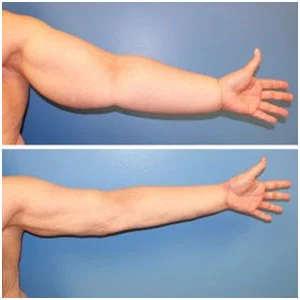What is lymphedema?
Lymphedema is an abnormal lymph drainage that caused a lots of fluid that could come with swelling, usually in the arms or legs. This condition may happen when human’s lymph system such as nodes become missing, removed or damaged. The Lymphatic system plays a very important role in our immune system through filtration of the lymph fluid and removal of excess lymph fluid with the help of our kidneys

Causes of Lymphedema:
Primary Lymphedema is rare and is caused by the absence of certain lymph vessels at birth, or abnormalities in the lymphatic vessels. Majority of this type appears before age 35 and occurs most often in the lower extremities.
Secondary Lymphedema occurs as a result of a blockage or interruption that alters the flow of lymph through the lymphatic system and can develop from an infection, malignancy, surgery, scar tissue formation, trauma, deep vein thrombosis (blood clot in a vein), radiation, or other cancer treatment.
Who Is At Risk For Developing Lymphedema?
People who have had any of the following procedures may be at risk for developing lymphedema:
- Simple mastectomy in combination with axillary (arm pit) lymph node removal.
- Lumpectomy in combination with axillary lymph node removal.
- Modified radical mastectomy in combination with axillary lymph node removal.
- Combined cancer surgery and radiation therapy to a lymph node region (such as the neck, armpit, groin, pelvis or abdomen).
- Radiation therapy to a lymph node region.
- Prostate Cancer.
- Abdominal Surgery.
- Congenital Disorder.
- Ovarian Cancer.
Lymphedema can occur within a few days, months, or years after surgery. A small amount of swelling is normal for the first four to six weeks after surgery.
The Signs And Symptoms Of Lymphedema
- Persistent swelling in the arms, hands, fingers, shoulders, chest, or legs. The swelling may occur for the first time after a traumatic event (such as bruises, cuts, sunburn, and sports injuries), after an infection in the part of the body that was treated for cancer, or after an extended (more than three hours) airplane trip (due to the sudden change in cabin pressure).
- A “full” or heavy sensation in the arms or legs.
- Skin tightness.
- Decreased flexibility in the hand, wrist, or ankle.
- Difficulty fitting into clothing in one specific area(ring, watch, bracelet, anklet tightness)
HOW CAN PHYSIOTHERAPY HELP?
Lymphedema Management in includes:
- Meticulous Skin Care keeping skin dry thoroughly including skin creases and between fingers and toes and keeping it always moisturized.
- Manual Lymphatic Drainage(MLD) a specific gentle massage that stimulates lymph flow and re-directs the lymph fluid to areas of the body where the lymphatic system is functioning. Special techniques help to break down fibrous tissue.
- Compression or Bandaging the application of stretch bandages(wrapping) or layers of gauze, foam and low stretch bandages to replace skin pressure lost from lymphedema. To enhance the effect of muscular activity in draining the lymph from the affected limb. These compression bandages also helps to soften fibrosis. They can be worn during sleep. Compression is applied by trained therapist but patients can be taught to bandage themselves.
- Range of Motion Exercises/Decompression exercises specifically designed light exercises to aid more in lymph resorption.
- Patient Education on skin care management, prevention of infections, self MLD, home exercises, self-bandaging and maintenance of the limb size.
- Elastic Support Garments/Sleeves provided to patient once effective limb size has been achieved.
Recommendations for patients with Lymphedema condition:
To help decrease the risk of further swelling, continue following the recommendations for preventing lymphedema listed above. In addition:
- Avoid extreme temperature changes. Do not use hot tubs, whirlpools, saunas or steam baths. Use warm, rather than very hot, water when bathing or washing dishes. Always wear sun protection (at least SPF 15) when going outdoors.
- Try to eat a balanced diet and maintain an average body weight. Obesity is linked to the development of lymphedema.
- Exercise regularly to promote improved circulation and maintained weight. Combined with deep breathing exercises and relaxation techniques such as yoga, swimming and water exercises.
- When traveling by air, ask your Lymphedema Therapist if you should wear a compression sleeve on your affected arm or a stocking on your affected leg. For long flights, additional bandages may be needed. Talk to your therapist before traveling.
- When sitting or sleeping, elevate your affected arm or leg on pillows. Avoid prolonged lying on your affected side.
- Wear gloves while gardening and cooking.
- Shave with an electric razor.
- Don’t go barefoot.
- Do not cross your legs when sitting.
- Do not carry your handbag with your affected arm.
- Avoid having injections and blood pressure readings performed on your affected limb.